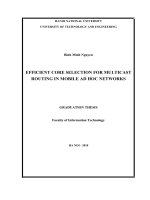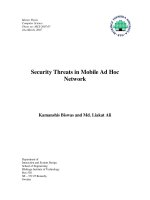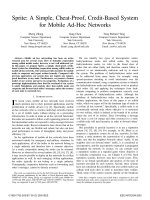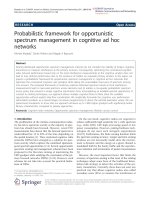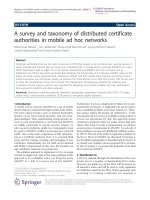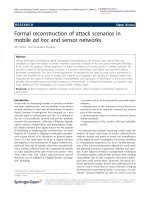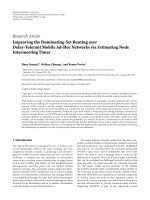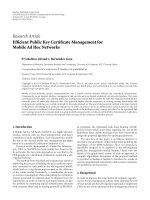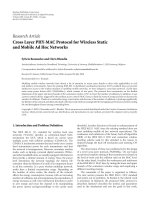Efficient core selection for multicast routing in mobile ad hoc networks
Bạn đang xem bản rút gọn của tài liệu. Xem và tải ngay bản đầy đủ của tài liệu tại đây (548.65 KB, 62 trang )
- 1 -
HANOI NATIONAL UNIVERSITY
UNIVERSITY OF TECHNOLOGY AND ENGINEERING
Binh Minh Nguyen
EFFICIENT CORE SELECTION FOR MULTICAST
ROUTING IN MOBILE AD HOC NETWORKS
GRADUATION THESIS
Faculty of Information Technology
HA NOI - 2010
- 2 -
HANOI NATIONAL UNIVERSITY
UNIVERSITY OF TECHNOLOGY AND ENGINEERING
Binh Minh Nguyen
EFFICIENT CORE SELECTION FOR MULTICAST
ROUTING IN MOBILE AD HOC NETWORKS
GRADUATION THESIS
Faculty of Information Technology
Supervisor: Dr. Dai Tho Nguyen
HA NOI - 2010
ABSTRACT
There are many multicast routing protocols that use the notion of group-shared trees,
for example: Protocol Independent Multicast (PIM), Core-Based Tree. As constructing of a
minimal-cost spanning tree to all members of the network is nearly impossible due to its
excessive cost in terms of convergence time and network overhead, the core-based
approach is chosen as a heuristic method to cope with multicast routing. The core node,
which is also referred as center node or rendezvous point, is chosen from a selective group
by different algorithm. However, most of protocols for core election in static networks are
not suitable for mobile ad hoc network, since these algorithms require the knowledge of the
whole network, the total number of nodes participating, the network topology, link state,..
Which are not available or too expensive to acquire in mobile ad hoc networks. There are
many proposed protocol for multicast routing in mobile ad hoc networks, such as PUMA,
ODMRP or MAODV. In those protocols, PUMA (Protocol for unified multicasting through
announcements) has shown to outperform others. PUMA uses a single multicast
announcement to establish and maintain the mesh. However, there is still a serious
drawback, PUMA elects core by selecting the node with the highest ID and the core
remains fixed afterwards. In this thesis, we present an improvement of PUMA by
integrating an adaptive core selection mechanism into it. The result show that the new
PUMA achieves higher packet delivery ratios, lower delivery times than the old one, while
incurring only a little control overhead increment.
- 3 -
ACKNOWLEDGMENT
This thesis would not have been possible without the support of many people.
Firstly, I am heartily thankful to my supervisor, Dr. Dai Tho Nguyen, whose encourage-
ment, guidance and support from the initial to the final step enabled me to develop a
throughout understanding of the subject.
I also would like to convey my thanks to the University of Technology and Engineering -
Hanoi National University for providing me the knowledge and experience in these four
years.
Lastly, I offer my regards and gratitude to all of those who supported me in any respect dur-
ing my studies.
Binh Minh Nguyen
Hanoi, May 2010
- 4 -
TABLE OF CONTENT
Binh Minh Nguyen ................................................................................................................................ 1
HA NOI - 2010 .................................................................................................................................. 1
HA NOI - 2010 .................................................................................................................................. 1
Binh Minh Nguyen ................................................................................................................................ 2
HA NOI - 2010 .................................................................................................................................. 2
- 5 -
TABLE OF FIGURES
Figure 1: Multicast.................................................................................................................................5
Figure 2: Multicast group......................................................................................................................7
Figure 3: Connectivity List..................................................................................................................20
Figure 4: Mesh Creation......................................................................................................................23
Figure 5: Multicast tree.......................................................................................................................33
Figure 6: Core Migration.....................................................................................................................41
Figure 7: Control overhead x Senders.................................................................................................46
Figure 8: Control overhead x Traffic Load.........................................................................................47
Figure 9: Packet loss ratio x Senders..................................................................................................48
Figure 10: Packet loss ratio x Traffic Load.........................................................................................48
Figure 11: Delivery time x Content Size.............................................................................................49
Figure 12: Delivery time x Number of concurrent requesting nodes...............................................50
Figure 13: Delivery time x Mobility...............................................................................................51
- 6 -
TABLE OF ABBREVIATIONS
ADMR Adaptive Demand-driven Multicast Routing
BGP Border Gateway Protocol
CBT Core-based Tree
DM Dense Mode
DVMRP Distance Vector Multicast Routing Protocol
ICMP Internet Control Message Protocol
IGMP Internet Grouping Management Protocol
IOS Internetwork Operating System
IP Internet Protocol
LAN Local Area Network
LSA Link-State Advertisement
MANET Mobile Ad Hoc Networks
MAODV Multicast Ad hoc On Demand Distance Vector
MOSPF Multicast Open Shortest Path First
MRT Maximum Response Time
NS Network Simulator
ODMRP On Demand Multicast Routing Protocol
OSPF Open Shortest Path First
OTcl Object-oriented Tool Command Language
P2MAN Peer-to-MANET
PIM Protocol Independent Multicast
PUMA Protocol for unified multicasting through announcement
RFC Requests for Comments
RPF Reverse Path Forwarding
SM Sparse Mode
SPF Shortest Path First
SPT Shortest Path Tree
TTL Time to Live
- 7 -
CHAPTER 1: INTRODUCTION
1.1 Overview
Multipoint communications have been existed for quite a long time. According to
researches, the idea of one or more nodes sending data packet to many receivers
simultaneously has been available since at least the early of 1980. The term multicasting
only became widely known after Deering established the first internet request-for-
comments on the field (aka RFC). [4]
After being proposed by Deering as the model to be followed by groups of users or
computers to communicate among themselves simultaneously, IP Multicasting has been
developed. Since then, a world-wide multicast backbone testbed also known as MBONE
has been constructed to test many protocols and applications.
Multicast communication has been implemented for a large number of applications.
Some of these applications are video-conferencing, whiteboard, group communication
tools, and software and information distribution. Initially, almost all of these applications
were being used in intranets or in MBONE, and now, there are some Internet service
providers providing supports for these multicast applications in their backbone.
1.2 Problem’s description
However, most of the research and development being done so far only consider
physically connected networks, where devices are connected together by the use of cables
and wires. Due to the wired connections among them, the locations of nodes are fixed and
the only dynamic aspect in the networks is node and link failures. Wireless networks are a
very attractive and promising way of computing due to computer and infrastructure devices
and computers are not cabled together. These networks constitute an environment where
everyone is free to move beyond the scope of his place. He can take his devices such as
computer, cell phone to anywhere and still be able to communicate, exchange information
with his colleagues.
The core of the thesis’s approach and contribution is multicasting over wireless
network, which consists of enabling the propagation of multicast data packets over
connected meshes. Multicasting over meshes is a significant departure for multicasting over
mobile ad hoc network. Meshes have a high tolerance toward faults of node or link failures.
Moreover, the algorithm used to build meshes is rather simpler and easy to deploy.
Among most representative multicast routing protocols, PUMA [5] has shown to be
the most stable and efficient protocol due to its performance compare with other protocols
such as MAODV or ADMR [10] … The most noticeable aspect of PUMA is that it uses a
very simple and effective method to establish and maintain the mesh, this results in a low
control overhead. PUMA uses a single control message, a multicast announcement to be
precise, to maintain the mesh. All transmissions are broadcast and no unicast protocol is
needed. PUMA uses a core-based approach to build the mesh. However, the method of
selecting core in PUMA has a serious drawback: PUMA selects the node with the highest
core id to become the core of the multicast group. Furthermore, core changes only happen
when the mesh undergoes partition or the old core leaves the mesh. In this thesis, we will
concentrate on improving PUMA in two aspects:
Firstly, create a function to determine which nodes should be the core node of the
multicast group. The core node should be able to reach every receiving node as quickly as
possible. Secondly, due to the mobility of the mobile ad hoc networks, the core node could
malfunction unexpectedly and no longer fit to be the core of the group. As a result, a core
change to cope with these exceptions should be implemented.
Inspired by the idea of core selection from [9], we propose an improvement of PUMA
with an adaptive core selection mechanism our own algorithm. Our work has made PUMA
perform approximately twenty percent better in term of delivery time than the old one. The
new implementation suffers from roughly two to five percent increase in total control
overhead, which we consider can be compensated by its superior delivery time and packet
delivery ratio. As an addition contribution, we also implement the algorithm for core
selection, which is described in [9] to compare with our algorithm. Still, our
implementation has shown to have lower control overhead, better packet delivery ratio, and
better delivery time.
1.3 Disposition
The rest of this thesis is organized as follows: Multicast is presented in chapter 2, and
in chapter 3, an in-depth description of PUMA is presented. Chapter 4 describes the
- 2 -
algorithm, implementation in details. Lastly, chapter 5 concludes this thesis with our
proposition, performance results and analysis.
- 3 -
CHAPTER 2: MULTICAST ROUTING
2.1 Introduction
Nowadays, a lot of emerging network applications requires the delivery of packets
from one or more transmitter to a group of receivers. These applications include bulk data
transferring (i.e., the transfer of a software upgrade from software developers to users
needing the upgrade), streaming of continuous media (e.g., the transfer of the audio, video
and text of a live lecture to a set of distributed lecture participants), sharing data
applications (i.e., a teleconferencing or whiteboard application that is shared among many
distributed participants), data feeds (e.g., stock quotes), and interactive gaming (i.e.,
distributed interactive virtual environments or multi-player games).
For each of these applications, a significantly useful abstraction is the notion of a
multicast: the sending of a packet from one sender to multiple receivers with only a single
"transmit" operation. In this section, we consider the network layer aspects of multicast.
2.2 Common mechanism
From the network perspective, multicast abstraction – a send operation that results in a
copy of the data sent and delivered to many receivers – can be implemented in several
ways. One possibility is for the sender to use a separate unicast transport connection to each
receiver. An application-layer [4] data unit that is forwarded to the transport-layer [4] is
then duplicated at the sender and then transmitted over each individual connection. This
approach is an implementation of one-sender-to-many multicast using the basic abstraction
layer unicast networks. It does not require explicit multicast support from the network layer
[4] to implement multicast abstraction but simulates multicast by using multiple point-to-
point unicasts. This is shown on the left of Figure 1, with a network router in the shade of
white, which means they are not actively involved in support multicast. In this example, the
multicast sender uses three separate unicast connections to three receivers.
- 4 -
Figure 1: Multicast
A second alternative provides explicit support for multicast at the network layer. In
second approach, a single datagram passed from the sending host. This datagram (or a copy
of this datagram) is then replicated in a network router whenever it must be sent over
multiple links to reach the recipient. The right side of Figure 1 illustrates this second
method, with certain routers shaded in green to indicate that they are actively involved in
supporting the multicast. Here, the sender transmits a single datagram packet. The router
within network then mirrors this datagram; a copy transfer to a recipient on the other end
and the other copy is transferred to the rightmost router. At the rightmost router, the
multicast datagram that is broadcast over Ethernet with two receivers connected to the
rightmost router. Apparently, this second approach towards multicast make more efficient
use of network bandwidth in which only a single copy of a datagram will ever go through a
link. Other the other hand, significant network layer support is necessary to make a
multicast-aware network layer. For the rest of this section we will focus on a multicast-
aware network layer, as this approach is done on the Internet and put out some interesting
challenge.
For multicast communications, we are immediately faced with two problems are much
more complicated in the case of unicast - how to determine the recipient of a multicast
datagram and how to address a datagram sent to the recipients. In the case of unicast
communication, the IP addresses of the recipient (destination) are made for each IP unicast
datagram and determine recipients only. However, in the case of multicast, we now have
- 5 -
more collection. Does it make sense for each to implement datagram multicast IP address of
all the many recipients? While this approach may be feasible with a small number of
recipients, it will not scale to the cases of hundreds or thousands of recipients, the amount
of information in solving datagram would swamp the amount of data actually carried in the
datagram's payload field. Explicit identification of the receivers by the sender also requires
that the sender know the identities and addresses of all of the receivers. We will see shortly
that there are cases where this requirement might be undesirable.
For these reasons, the Internet architecture, a multicast datagram aims to address
indirection. That is, an "identifier" is used for the group of receivers, and a copy of the
datagram that is addressed to the group with the single "identifier" is supplied to all
multicast receivers associated with that group. In the Internet, the single "identifier", which
represents a group of receivers, is a class D multicast address. The group of receivers
associated with a class D address is referred to as a multicast group. The multicast group
abstraction is illustrated in Figure 2. Here are four hosts (shown in red) in relation to the
group multicast and receives all multicast datagram that address. The problem that we need
is that each host a unique IP address is the unicast address that is completely independent of
the address of the multicast group in which it participates.
- 6 -
Figure 2: Multicast group
While the multicast group abstraction is simple, it raises many questions. How does a
group get started and how does it terminate? How is the group address chosen? How are
new hosts added to the group (as senders or receivers)? Can anyone join a group (and send
to, or receive from, that group) or is group membership restricted and if so, by whom? Do
group members know the identities of the other group members as part of the network layer
protocol? How do the network routers interoperate with each other to deliver a multicast
datagram to all group members? For the Internet, the answers to all of these questions
involve the Internet Group Management Protocol [RFC 2236]. So, let us next consider the
IGMP protocol and then return to these broader questions.
2.3 Multicast routing in LAN
IGMP (Internet Group Management Protocol) protocol developed from the Host
Membership Protocol, described in the documents of Deering. IGMP development IGMPv1
(RFC1112) to IGMPv2 (RFC2236) and the final version of IGMPv3 (RFC3376). IGMP
messages are sent inside IP packets with the protocol number of 2, in which the TTL value
by 1. IGMP packets are transmitted only in the LAN and not be further transferred to other
LAN the TTL value of it. Two of the most important goal is IGMP:
- 7 -
- Inform the multicast router is a machine that wants to receive multicast traffic of a specific
group.
- Notice that a router is a machine to leave a multicast group (in other words, a computer is
no longer interested in receiving multicast traffic again). The IGMP router used to maintain
information for each port of the router is the router multicast group does need to move and
want to get the host.
Before a host can do any multicast traffic, a multicast application to be installed and
running on that host. After a host to join a group, the software will calculate a multicast
address and network card will then start listening to a multicast MAC address. Before a host
or a user wants to join a group, users need to know if the group exists and how to join that
group. For application level programs, users simply click a link on a website or multicast
addresses can be preconfigured on the client. For example, a user may be required to log
into a server and authenticate with user name and. If the username is authenticated,
multicast applications are automatically installed on the user's PC, meaning users have to
participate in the multicast group. When users no longer want to use multicast applications,
users must leave the group. For example, users simply close the application for leave
multicast groups. For multicast mechanism, a user needs to find out what they want to run
applications, multicast address used by applications.
How a router to know the machine needs to hear the multicast traffic? To receive
multicast traffic from a source, both the source and the receiver must first join to a multicast
group. This group was identified through a multicast address. A host can join a multicast
group by sending requests to the nearest router. Operations are conducted through IGMP
protocol. IGMPv1 is defined in RFC1112 and its improvements, IGMPv2 is defined in
RFC2236. When there are few hosts want to join the group, PIM protocol will inform each
other between the router and the multicast tree formed between routers. IGMP and ICMP
have many similarities, share some similar functions. IGMP is also packed in packets (IP
protocol number 2), but only IGMP limit in a layer 2 connection. To ensure continued
router never transfer packets, the TTL field of IGMP always equal to 1.
2.3.1 IGMPv1
- 8 -
Every 60 seconds, a router on each network segment will send the query to all hosts to
check if this host is also interested in receiving multicast traffic again. This router is called
query IGMPv1 Querier router and its function is to invite the host to join the group.
If a host wants to join a group, or it wants to continue receiving traffic from a group
that was involved, it must respond with the membership-report message. The host can join
the multicast group at any time.
However, IGMPv1 has no mechanism to enable a host to leave a group if that host is
no longer interested in the contents of that multicast group. Rather, the router will conclude
a port of the bundle does not belong to a multicast group if the router does not receive
message-report membership for three consecutive cycles’ queries. This means that, in
default mode, the multicast traffic is sent on a network segment in three consecutive cycles
after querying all members of the group who no longer listen to multicast traffic.
In addition, the router cannot keep a complete list of machines for each multicast group
members. Instead, it needs to do is save the multicast group exists on the gate of it.
A message has IGMPv1 five fields:
1. Version: This field is 4-bit length, always with an assigned value.
2. Type: School 4bit value, indicating two types of messages defined by IGMPv1. Type 1 is
the type Host Membership Query, which is used only by routers. Type 2 is the type of Host
Membership report was used only by the host.
3. Unused: 8bit length field contains the value 0 when sent and ignored when received.
4. Checksum: 16bit checksum value is calculated by the source of the IGMP messages.
Equipment typically receives checksum value and check if this value is not exactly equals
the calculated value, the receiver will remove the frame.
5. Group Address: The value assigned to the router 0.0.0.0 Membership query packet sent
out. This value is the value assigned to the multicast group address when sending a
Membership report message.
Note that when you combine two versions and the type, the value of a hexadecimal
IGMPv1 Host Membership Query packet is 0x11 and a 0x12 IGMPv1 Host Membership
report. These values are compared with the values of IGMPv2.
Function send Host Membership Report:
The host used IGMPv1 Host Membership report message to respond to IGMP query
packets and inform the router that the computer wants to receive multicast. The host
- 9 -
IGMPv1 report uses multicast messages to communicate with the router, specifies the
multicast group address to which it would like to receive. In IGMPv1, a host sending a
message IGMPv1 Host membership report under the following circumstances:
- When a host receives a packet IGMPv1 Query from the router, the host will assume
HostMembership report sent to all multicast group that it wants to receive traffic. This
message is called IGMPv1 Solicited Host Membership report.
- When a host to join a new group, it wants to send out immediately IGMPv1 Host
Membership report to inform the router that it wants to receive traffic for that group without
waiting for IGMPv1 Query packet. This message is called unsolicited IGMPv1 Host
Membership report.
IGMPv1 Querier Router query:
To increase reserves, we can implement multiple multicast routers on the same network.
Nevertheless, if all the routers send packets every 60 seconds, the query would be very
wasteful of bandwidth. Thus, a router should have assigned the role to send query packets
and multicast traffic transmitted into or out subnet. If a router is down, second router can
assume responsibility. IGMPv1 usually based on the multicast routing information to solve
this problem elect router.
2.3.2 IGMPv2
IGMPv2 version introduces several differences compared with the first version. The
query packet is now known as General Queries. These packages can be sent to address all-
hosts or to specific groups. Another improvement is that the hosts are allowed to leave the
group. When a host leaves a group decided to join it, it sends messages to LeaveGroup all-
routers address. All routers on a network segment will heed the message and the router will
continue the query process. The router will respond with a message on the message sent by
the group access. This message will ask that there is also host to groups that want to get
traffic again. Any host should respond by membership report messages. Otherwise, the
router will safely conclude that moving traffic is not necessary for that group on that
network segment. Around this time, the default is 3 minutes. One of the reasons for
developing the IGMPv2 is that it provides a mechanism to leave the group better. IGMPv2
has added some new features:
- 10 -
- Group-specific Query: allows the router to send query for a specific group rather than for
all group
- Maximum Response Time: A new field in the query packet, allowing the adjustment
period for host membership report message. This feature can be useful when a large number
of groups exists on a subnet and you want to reduce the number of messages responded by
prolonged response messages over a longer period.
- Leave group message: allow hosts to inform routers that hosts want to leave the group.
- Query router rating: Provide mechanisms for routers to send out the vote message when a
query with multiple routers connected to a subnet.
Membership report message is sent when a host to join a group. Occasionally, this
type of message is also used to answer queries from the query router. When a host to join a
group, it will not wait for query packet from the router. Instead, it will send a membership
report. Destination address of the membership report is the group destination address. To
ensure that the router receives this message, hosts will send several messages, each 10
seconds apart.
IGMP v2 has four fields, is defined as follows:
1) Type: 8bit length field, indicating one of four types of messages defined by IGMPv2.
The possible values are:
a. Membership query (value 0x11): used by routers to find the presence of hosts
on a subnet. The message of this type of value assigned to the group address as in
IGMPv1 0.0.0.0. A query message for a given group will address the group in this
field. A message of this type is usually sent when the router receives a leave group
message from a host IGMPv2 leave group. The message type is used to determine
if there, still any member of a particular group.
b. Version 1 Membership report (code 0x12): used by IGMPv2 for compatibility
with IGMPv1
c. Version 2 Membership report (code 0x16) is sent by the member to notify the
router when there is at least one member on the network.
- 11 -
d. Leave Group (0x17): submitted by members of the group if it is the last member
to send membership report messages. The router that hosts the message are
reported for leaving the group
2) Maximum Response Time (Maximum Response Time): 8bit length of query messages.
The default value for this field is 100 (approximately 10 seconds). The value will change
from 1 to 255 (i.e., from 0.1 seconds to 25.5 seconds).
3) Checksum: Contains 16bit values calculated by machine source. IGMP checksum
calculated over the entire load of the IP, not just the first 8bytes although 8bytes IGMPv2
length.
4) Group Address: Assign the value of the query packet and assigns the group address if the
message is specific to each group. The membership report messages or leave group
messages can carry the group's address in this field.
If there are multiple routers on the same connection, the router with the smallest IP
address will send out query packets. Therefore, when a router receives a packet from a
router, it will check the source address of the packet there. If the source address of the
router is under a local source address in packet arrival, the router will continue to send a
query packet because it knows that it will function as the query. If the source address of
query packets is smaller, the router will abandon the role query.
IGMPv2 support backward compatibility with IGMPv1. Code for the type of query
and report messages of IGMPv2 and IGMPv1 are the same as 0x11 and 0x12. This allows
hosts and routers running IGMPv2 realized IGMPv1 hosts on the network. IGMPv2 helps
reducing the number of report messages sent by the host by allowing the administrator to
change the query time. IGMPv1 has no parameters Maximum Response Time (MRT), so
the host simply use the default period is 10 seconds. However, IGMPv2 messages include
the MRT; MRT indicates the time used by all hosts on the LAN IGMPv2. The process of
the host sending the message Report is the same in IGMPv1 and IGMPv2. There is a small
difference is the router IGMPv2 queries sent packets every 125 seconds instead of every 60
seconds.
The process IGMPv2 query and report use a query mechanism for specific groups. In
IGMPv2, when a host leaving a group, it sends out a group of IGMPv2 leave messages.
When a router receives messages, IGMPv2 leave group, instead of waiting for a period of
- 12 -
125 seconds, the router will immediately send a query message for that group. This
message is just to ask if the host also want to receive multicast traffic for that group.
The primary advantages compared IGMPv2 with IGMPv1 is that IGMPv2 provides a
mechanism for a host to leave the multicast group faster.
2.4 Multicast Routing in Internet
2.4.1 Distance Vector Multicast Routing Protocol (DVMRP)
RFC 1075 describes the first version of DVMRP. DVMRP has many versions. The
activities of DVMRP PIM-DM are similar. The differences between PIM-DM and DVRMP
are defined as follow:
- Cisco IOS does not support DVMRP, but it supports connection to a DVMRP network.
- DVMRP routing protocol itself, is similar to RIPv2. It sends updates every 60 seconds and
32 is the limit on the hop. DVMRP routing protocol should take its own additional costs
compared with PIM-DM.
- DVMRP probe messages used to find neighboring routers.
2.4.2 Multicast Open Shortest Path First (MOSPF)
MOSPF is defined in RFC1584, is an extended version of the unicast routing
protocols OSPFv2. MOSPF's basic operations are described as follows:
- MOSPF LSA group use the type 6 address. Along with unicast OSPF, all MOSPF routers
in one area must have the same database link so that all MOSPF routers in an area can be
calculated with a SPT algorithm.
- SPT algorithm is calculated on demand.
- Update the calculation process; all the routers know where the group members based on
group membership LSAs.
- After some SPF calculations are completed, the information will be included in multicast
routing table.
- Like OSPF unicast routing, shortest path tree is not a loop and know all the router ports
upstream / downstream. The result does not need the RPF check.
- MOSPF can only work with OSPF unicast routing. MOSPF is suitable for small networks.
When multiple machines start sending multicast traffic, the routers have to perform some
- 13 -
calculations Dijkstra, result in wastage of CPU resources. Cisco IOS does not support
MOSPF.
2.4.3 PIM
2.4.3.1 PIM dense mode (PIM-DM)
The PIM router can be configured by type Dense Mode (also called PIM-DM) if the
hosts are participating in multicast group located anywhere within the subnet. Multicast
source address becomes the root of the tree and a multicast tree is built from source to
destinations. This mechanism is also known by the symbol (S, G) in which the path from
source to group members is unique. PIM-DM is useful when sending and receiving
machines are close together and multiple machines send and receives high-density traffic
multicast, but multicast traffic flow did not change. Multicast tree is built by allowing the
dispersal of traffic from source to all routers in the network. Tree will grow from top to
bottom. In a short time, the unnecessary traffic flow will be like in the broadcast traffic.
Nevertheless, when the router receives traffic for a group, the router will decide it wants the
computer to receive data or not? If yes, the router will remain silent and continue to flow. If
no host registers for that Multicast group (via IGMP), the router would sends Prune
message to its neighboring routers in the direction of the root of the tree. Branch of the tree
will then be removed so that unnecessary traffic will not be distributed in that direction.
Multicast tree will be built according to the requirements to join the group. Then the
router which can not join the hosts will be deleted from the tree. PIM-DM will recognize
neighboring devices by exchanging hello packets. Neighbor information is used first to
build the tree to all its neighbors. Then, the branch of the tree will be removed in turn.
When a multicast stream starts, the tree will be built. Trees will only exist when its
members remain active. If a new host joins the group, branch of the network segment will
be attached to the tree.
2.4.3.2 PIM sparse mode (PIM-SM)
Multicast routing protocols dense mode is useful when the application is multicast
dense traffic and you need to distribute virtually the entire network. However, if the user
has only a few subnets, routing protocols dense rule will remain spread over the entire flow
of inter-network, wasting bandwidth and resources. In these cases, sparse style routing,
- 14 -
PIM-SM instance can be used to reduce the wastage of network resources. The basic
difference between dense mode and sparse mode related to its default state. By default, the
protocol rule of dense traffic continued to pass unless a group of routers below indicates
that it does not want to get that traffic. The sparse mode protocol does not transmit traffic to
any router of the group unless it receives a message request copies of the packet for a
multicast group. Neighboring routers receive packets only require one to two purposes:
- The router has received a request to receive a packet from the router.
- A host on a network segment sent IGMP Join message for that group.
Operation of the PIM sparse mode began when the packet is pushed on a special
router called the Rendezvous Point (RP). When the flow of the RP group, unlike in the
dense, no RP router to automatically push any traffic on any router. A router must request
this flow.
2.5 Multicast routing in ad hoc networks
2.5.1 Tree-based approaches
Tree-based multicast is a well defined concept in cable network. Most schemes for
offering multicast in cable networks are either source-or shared-tree-based. Various
researchers have attempted to extend tree-based effort to support multicast in a MANET s
environment. This section provides an overview of some of these approaches.
- Ad Hoc Multicast Routing Protocol Utilizing Increasing ID Numbers (AMRIS) is an
on-demand protocol that builds a shared multicast delivery tree to support multiple
transmitters and receivers in one multicast session. AMRIS dynamically assigns an ID
number to each node in each multicast session. Based on the ID number, a multicast
delivery tree - established at a specific node with Smallest-ID (S
id
) - is created and ID
number increases with tree extends from S
id
. To sum up, S
id
is the source or the node
that initiates a multicast session.
- Multicast Ad hoc On-Demand Distance Vector (MAODV) Protocol – MAODV
determines multicast routes on demand by a broadcast path discovery mechanism to apply
the identical route request (RREQ) and route reply (RREP) messages found in the unicast
AODV protocol. A mobile node forms a RREQ message when it wants to join a multicast
group or has information to send to a multicast group, but exists no route to this group.
- 15 -
Only one member of the preferred multicast group may react to a join RREQ. If the RREQ
is not a JOIN request, whichever node with a new adequate route (based on group sequence
number) to the multicast group can reply. If a transitional node receives a join RREQ for a
multicast group to which it is not a member, or, it receives a RREQ and not has a route to
this group; it rebroadcasts the RREQ to its neighbors.
2.5.2 Mesh-based approaches
Unlike a tree approach, mesh-based multicast protocols may have numerous paths
between any source and destination. Presented studies show that tree-based protocols are
not essentially best for the multicast in a MANET where network topology changes
regularly. In such a situation, mesh-based protocols seem to do better than tree-based
protocols due to the availability of alternative paths, which allows multicast datagram to be
transmitted to the recipients even if the links stop working. This section presents an
overview of some of the mesh-based approaches in a MANET.
On-Demand Multicast Routing Protocol (ODMRP) — ODMRP is a mesh-based
protocol that uses a forwarding group concept. A soft state advance is taken in ODMRP to
preserve multicast group members. No unequivocal control message is necessary to leave
the group. In ODMRP, group membership and multicast routes are built and updated by
demand of the source. When a multicast source has packets to transmit, having no route to
the multicast group, it broadcast a Join-Query control packet to the whole network. This
Join-Query packet is regularly broadcast to update member information and routes. When a
transitional node receives a Join-Query packet, it keeps the source ID and sequence number
in its message cache to identify any possible duplication. Routing table is updated with a
proper node ID (i.e. backward knowledge) from which message is received. If the message
is not a replica and TTL is greater than zero, it is rebroadcast.
Core-Assisted Mesh Protocol (CAMP) helps multicasting by creating a common mesh
for each multicast group. Meshes then created help maintain connection for multicast users,
even with moving node. It based on concepts from CBT, but in contrast to CBT where all
traffic flows through the central node, the central nodes in CAMP are used to limit the
control traffic. The fundamental operation of CAMP includes construction and
maintenances the multicast meshes for a multicast group. It requires a mapping service that
gives routers with the addresses of groups identified by their names. It also involves access
- 16 -
to router information from a unicast routing protocol. Each router maintains a routing table
(RT). CAMP adapts this table when a multicast group must be inserted or removed. Based
on RT, a multicast routing table (MRT) was built. A router can update its MRT based on
topological changes or communication received from its neighbors.
2.6 Conclusion
Steve Deering wrote the first RFC for multicast mechanism in 1986. Nevertheless, a
few years later, the huge demand for multicast mechanism has exploded, from a
communication needs such as audio, video, TV programs ... Multicast also has been studied
as a component of the Internet, known as Project Multicast backbone, Mbone. Today, as the
need for a protocol that can be used for moving devices, such as cell phone, cars,.. many
protocols for MANETs have been proposed such as CAMP, MAODV. It will be interesting
to see how the deployment multicast routing in MANETs plays out over the next decade of
computer networking.
- 17 -
